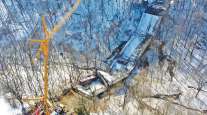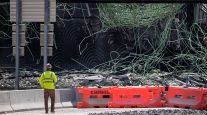Washington State’s I-5 Bridge Reopens
This story appears in the June 24 print edition of Transport Topics.
Washington state’s Skagit River bridge has reopened a month after a truck hauling an oversize load hit one of its trusses and caused a partial collapse.
The June 19 opening reconnects Interstate 5, the major traffic artery between Seattle and Vancouver, British Columbia.
“The full morning [traffic peak] went over the bridge,” Travis Phelps, spokesman for the Washington State Department of Transportation, said the day of the opening.
The incident occurred May 23, sending vehicles into the river. The occupants were pulled to safety.
The collapse focused renewed attention on the state of the nation’s infrastructure.
All four bridge lanes, which carry 71,000 vehicles a day, are open after the temporary span’s hasty construction, but the speed limit was reduced to 40 mph from 60 mph. And oversize trucks requiring special permits are banned until Oct. 1, when permanent repairs are complete, Phelps said.
“It’s a main freight corridor,” he said of the I-5 bridge. “The majority of the freight going to and from Seattle and Vancouver, British Columbia, goes through there.”
The collapse, still under investigation by the National Transportation Safety Board, sparked new calls for greater infrastructure investment, particularly in bridges.
On the same day the bridge reopened, Democrats on the U.S. House Transportation and Infrastructure Committee introduced a bill to spend $5.5 billion to upgrade or replace 150,000 bridges deemed deficient or functionally obsolete by the
Federal Highway Administration, the agency that monitors the condition of the nation’s 605,000 bridges.
“Congress simply cannot keep hitting the snooze button when it comes to needed investment . . . or think that these aging structures can be rehabilitated with rhetoric,” the committee’s ranking Democrat, Rep. Nick Rahall (W.Va.), said in a statement.
Committee member Rep. Rick Larsen (D-Wash.), whose district includes the bridge, said, “We can’t keep waiting until they crumble into the water.”
Transportation for America, a national transportation advocacy group based in Washington, D.C., released a new report indicating that one in nine of the bridges and overpasses American drivers cross each day is in such poor condition that they could “become dangerous or be closed without near-term repair.”
The report, based on an analysis of the FHWA data, cites five states with the worst bridges: Pennsylvania, Oklahoma, Iowa, Rhode Island and South Dakota.
Nearly 67,000 bridges in the country are rated “structurally deficient” and in need of substantial repair. About 8,000 are structurally deficient and “fracture critical,” meaning their design has no redundancy, so if one component fails, the bridge could collapse.
That’s what happened with the Skagit River bridge, Washington officials said. When the truck belonging to Mullen Trucking of Aldersyde, Alberta, struck the truss, other sections failed. The truck was preceded by the required pilot car with a vertical pole to guard against such strikes and had a state oversize-load permit.
State and federal transportation agencies worked quickly to get the temporary fix in place, given the economic importance of the bridge and the effects on the towns of Burlington and Mount Vernon, just north of Seattle.
“Basically, that is the main drag, if you look at our commerce,” State Rep. Judy Clibborn (D-Mercer Island), chairwoman of the Washington House Transportation Committee, said of the I-5 corridor.
Clibborn also said the bridge collapse has heightened interest in the special legislative session now under way in Washington state, where a measure she introduced earlier this year to provide new funding for transportation projects is being debated.
The bill includes a proposed 10.5-cent increase in the state’s 37.5-cent diesel and gasoline tax, which would be phased in over 12 years to help raise $9 billion for roads and bridges, she said.



